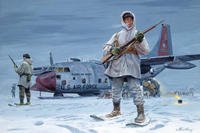Alaska has long been one of the least understood places in the Western Hemisphere. People the world over underestimated the area's value, with the notable exception of Secretary of State William Seward, who negotiated its purchase in 1867. Still, newspapers called it "Seward's Folly."
Even after finding gold in Alaska, the U.S. believed it was too remote to defend or contribute to the national defense. It also believed Japan would have no interest in Alaska. As World War II began to loom over the country, the U.S. military moved the National Guard out of the region, leaving it practically defenseless.
Alaska National Guard Maj. Marvin "Muktuk" Marston decided that leaving Alaskans without protection was just unsat. He set out to enlist and organize a force of Alaskans to defend the territory's more than 6,000 miles of coastline, an effort that culminated in the formation of the Alaska Territorial Guard (ATG).
Because many members of the ATG came from Alaska's indigenous community, the unit earned the nickname "Eskimo Scouts."
The U.S. Army's assessment of Japanese forces being uninterested in Alaska was quickly dispelled. Just a little more than six months after the bombing of Pearl Harbor in Hawaii, Japanese forces could be sighted off the coast of Alaska, made bombing raids on Dutch Harbor and occupied a number of uninhabited places in the Aleutian Islands.
Japanese crewmembers even departed their ships and made landfall in Alaska to question the local population, Marston would later write in his biography. When Japanese aircraft were sighted over St. Lawrence Island, he conceived the idea of getting native Alaskans to help form a home guard.
Alaska, it turns out, became much more strategically important than Army planners realized. The great northern territory contained the only source of platinum in the entire Western Hemisphere. It was also where American and Soviet pilots picked up U.S.-made aircraft as Lend-Lease supplies from the U.S. made their way to Europe's Eastern Front.
Marston was soon tasked to serve Alaska's territorial governor, Ernest Gruening, as a military aide and pitched his idea of recruiting indigenous people to form a defense for the territory. The two men set off to begin recruiting for the new Alaska Territorial Guard the same month that Japanese forces landed on the Aleutian Islands of Attu and Kiska.
When his transport aircraft failed to arrive, Marston took to the countryside in a way only Alaskans would: by dogsled. He would make a trip of 680 miles by that method, recruiting Aleut, Yupiaq and Alaskans with other tribal affiliations, along with non-indigenous Alaskans living in the territory.
Only 21 people were paid members of the service, while more than 6,300 volunteered their time from more than 100 areas in the territory. Many indigenous Alaskans were well suited for the work, having been lifelong hunters and trackers with intimate knowledge of the land and its climate.
Volunteers would get training in military drill and organization, as well as ways to identify ships and aircraft. They dedicated themselves to defending America's only source of platinum while protecting the routes of Lend-Lease aircraft headed for the Soviet Union. The Alaska Territorial Guard also kept a watch over the Alaskan coastline for infiltrators, incendiary balloons and potential Japanese survey ships.

Although many of the members of the ATG were unpaid at the time, they have since been recognized as veterans of World War II and are eligible to apply for any relevant benefits.
Those who served in or worked for the ATG came from many races and backgrounds, making it one of the earliest mixed-race units in the armed forces of the United States and one of the earliest mixed-gender units.
There was another significant first in the ATG: 26 of the 27 women who served in it were nurses, but one volunteer was put on combat duty for her skills with a weapon. She may have never seen combat, but she was among the first women in the Army officially placed in a combat position.
Much of Alaska's interaction with the Imperial Japanese Army and Navy came before the formation of the territorial guard, but the guard still served Alaska until 1947. Members would reconvene more than a decade later to help Alaska achieve statehood and end segregation of indigenous people in the territory.
-- Blake Stilwell can be reached at blake.stilwell@military.com. He can also be found on Twitter @blakestilwell or on Facebook.
Want to Learn More About Military Life?
Whether you're thinking of joining the military, looking for post-military careers or keeping up with military life and benefits, Military.com has you covered. Subscribe to Military.com to have military news, updates and resources delivered directly to your inbox.
















